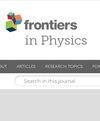Theory of Turing pattern formation and its experimental realization in the CIMA reaction system in the presence of materials lowering the diffusivity of activators
IF 1.9
3区 物理与天体物理
Q2 PHYSICS, MULTIDISCIPLINARY
引用次数: 0
Abstract
In 1952, Alan Turing accomplished a pioneering theoretical study to show that the coupling of nonlinear chemical reactions and diffusion leads to the instability of spatially homogeneous states. The activator and inhibitor are synthesized as intermediates of the reaction system in the Turing model. Turing found that spatially periodic stationary concentration patterns are spontaneously generated when the diffusion coefficient of the activator is lower than that of the inhibitor. The first experimental realization of the Turing pattern was achieved in 1990 in a chlorite–iodide–malonic acid (CIMA) reaction system. Iodide and chlorite anions act as the activator and inhibitor of this reaction system, respectively. Although there is no significant difference in the diffusion coefficient of iodide and chlorite anions, the Turing pattern was generated because starch was added to the gel reactor to enhance the color tone. This formed a complex with iodide to inhibit its diffusion to satisfy the condition for the Turing instability. Several examples were found after this finding. We focused on the high affinity of quaternary alkyl ammonium cations to iodide. The CIMA reaction was performed in an open gel reactor by adding a quaternary alkyl ammonium cationic surfactant. In addition, the polymer gel consists of the quaternary alkyl ammonium group as the side chain was utilized for the open gel reactor. The micelles of the surfactants and the polymer gels trapped iodide in their vicinity as a counter anion to lower the effective diffusivity to satisfy the condition for the Turing instability.图灵模式形成的理论及其在 CIMA 反应体系中的实验实现,在存在降低活化剂扩散性的材料的情况下
1952 年,阿兰-图灵完成了一项开创性的理论研究,证明非线性化学反应和扩散的耦合会导致空间均质态的不稳定性。在图灵模型中,激活剂和抑制剂是作为反应系统的中间产物合成的。图灵发现,当激活剂的扩散系数低于抑制剂的扩散系数时,空间周期性静止浓度模式就会自发产生。图灵模式的首次实验实现于 1990 年的氯石-碘化物-丙二酸(CIMA)反应体系。碘离子和亚氯酸盐阴离子分别作为该反应体系的活化剂和抑制剂。虽然碘离子和亚氯酸根阴离子的扩散系数没有明显差异,但图灵模式的产生是因为在凝胶反应器中加入了淀粉以提高色调。这与碘化物形成了复合物,抑制了碘化物的扩散,从而满足了图灵不稳定性的条件。在这一发现之后,我们又发现了几个例子。我们重点研究了季烷基铵阳离子与碘化物的高亲和性。通过添加季烷基铵阳离子表面活性剂,CIMA 反应在开放式凝胶反应器中进行。此外,开放式凝胶反应器还使用了由季烷基铵基作为侧链的聚合物凝胶。表面活性剂和聚合物凝胶的胶束将碘化物作为反阴离子截留在其附近,从而降低了有效扩散率,满足了图灵不稳定性的条件。
本文章由计算机程序翻译,如有差异,请以英文原文为准。
求助全文
约1分钟内获得全文
求助全文
来源期刊

Frontiers in Physics
Mathematics-Mathematical Physics
CiteScore
4.50
自引率
6.50%
发文量
1215
审稿时长
12 weeks
期刊介绍:
Frontiers in Physics publishes rigorously peer-reviewed research across the entire field, from experimental, to computational and theoretical physics. This multidisciplinary open-access journal is at the forefront of disseminating and communicating scientific knowledge and impactful discoveries to researchers, academics, engineers and the public worldwide.
 求助内容:
求助内容: 应助结果提醒方式:
应助结果提醒方式:


